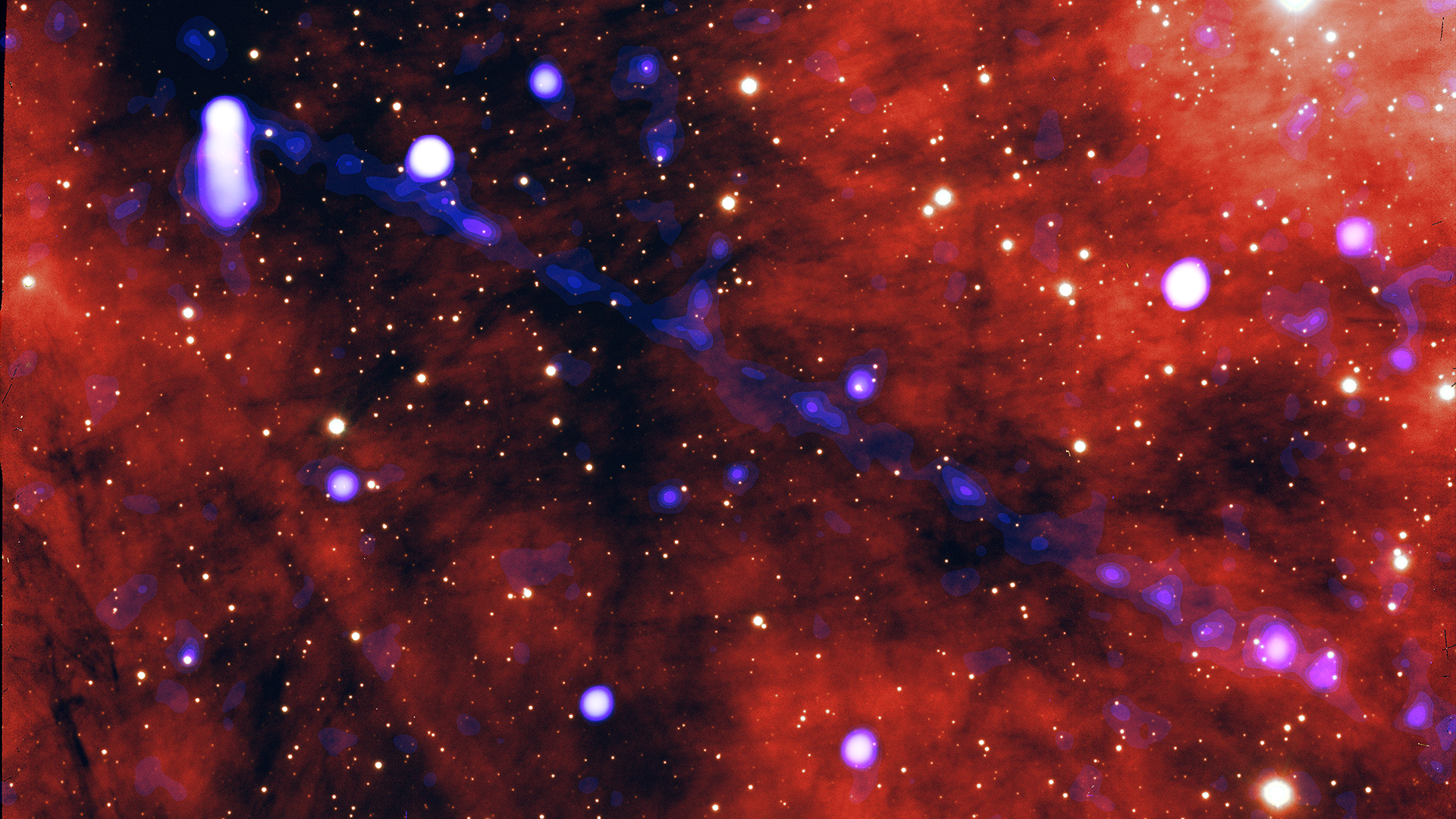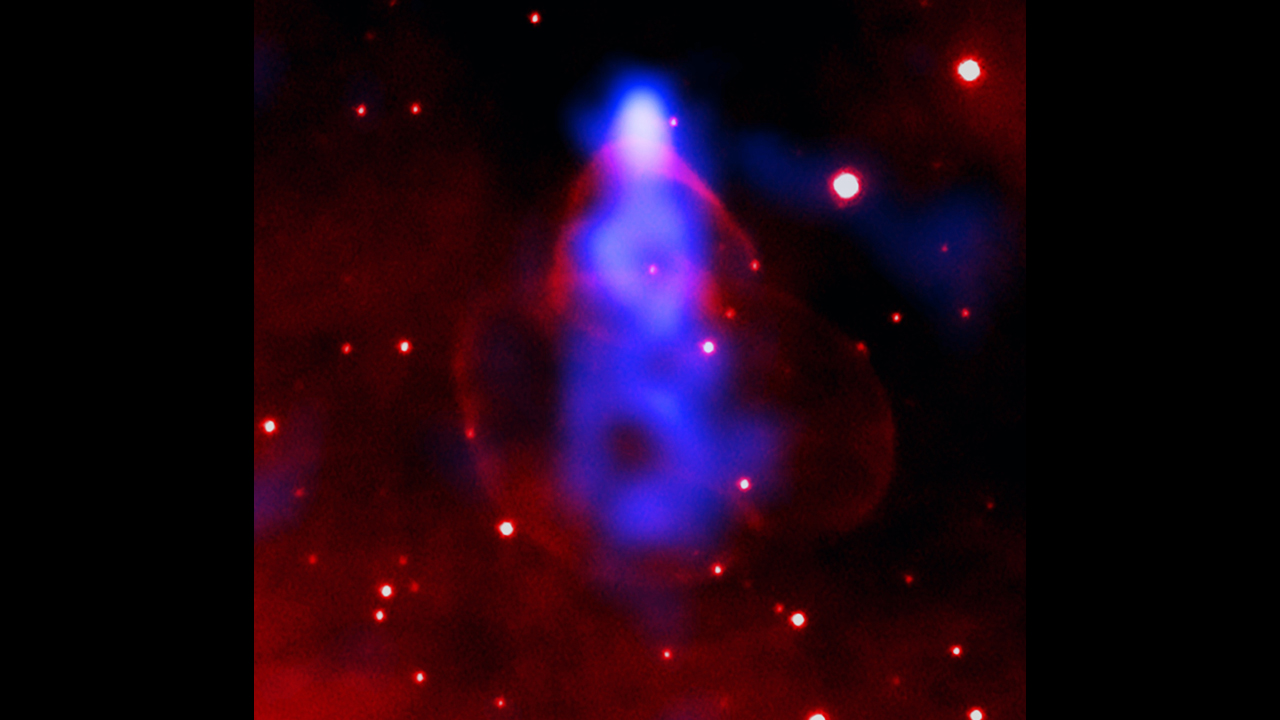NASA caught a dead star spewing antimatter across space in dazzling new image
The particle stream extended into space for trillions of miles.

A small pulsar has belched out an enormous beam of matter and antimatter particles that streamed for 40 trillion miles (64 trillion kilometers) across the Milky Way.
Astronomers detected the cosmic particle trail in images captured in X-rays by NASA's Chandra X-ray Observatory in space and in optical light by the Gemini North telescope in Hilo, Hawaii.
Observations of X-ray filaments emitted by pulsars are rare; to date, only a handful have been detected, researchers reported in a new study.
Pulsars are dense, shrunken remnants of giant collapsed stars that emit radiation pulses as they spin, and they have powerful magnetic fields that are generated by their rapid rotation. This pulsar, known as PSR J2030+4415 (J2030 to its close friends) spins about 1,600 light-years from Earth and is relatively tiny — just 10 miles (16 km) in diameter, or about the size of a city, NASA representatives said in a statement.
This fast-spinning pulsar travels through space at about 500,000 mph (800,000 km/h) and rotates about three times per second; as it spun, charged particles escaped as a streaming filament that was then captured in telescope images. The scope of J2030's particle stream could explain why the Milky Way contains so many positrons, the antimatter counterparts of electrons, according to the statement.
Related: The 12 strangest objects in the universe
Images of J2030 captured in 2020 and 2021 revealed the extraordinary length of the filament, and also showed particles in a cloudlike halo surrounding the pulsar. In Chandra's new X-ray views, shades of blue indicated where particles streamed far from the pulsar along magnetic-field lines, moving at about one-third the speed of light, while reddish hues in the images depicted light spied by Gemini in the visible part of the spectrum. The findings were published online Feb. 7 in the preprint database arXiv and have not been peer-reviewed. (The study will appear in The Astrophysical Journal on an undisclosed date, according to the statement.)
Get the world’s most fascinating discoveries delivered straight to your inbox.
"It's amazing that a pulsar that's only 10 miles across can create a structure so big that we can see it from thousands of light-years away," said lead study author Martijn de Vries, a postdoctoral scholar at the Kavli Institute for Particle Physics and Cosmology at Stanford University. "With the same relative size, if the filament stretched from New York to Los Angeles, the pulsar would be about 100 times smaller than the tiniest object visible to the naked eye," de Vries said in a statement.
Pulsars have powerful magnetic fields that usually confine whipping winds of charged matter and antimatter particles close to the collapsed star. As a pulsar travels through space, its magnetic field interacts with nearby solar winds and gases, which build up as they travel ahead of the pulsar, like a wave of water pushed along by the prow of a boat.
About 20 to 30 years ago, something disrupted the momentum of the wave produced by J2030, and the pulsar slammed into it; the collision likely triggered a particle leak and sprayed a stream of particles into space, study co-author Roger Romani, a physics professor at the Kavli Institute, said in the statement.
"The pulsar wind's magnetic field linked up with the interstellar magnetic field, and the high-energy electrons and positrons squirted out through a nozzle formed by connection," Romani said.
Most of the matter in the universe is normal matter; antimatter is matter with the opposite electric charge. In pulsars, a combination of speedy rotation and strong magnetic fields creates a perfect storm of powerful radiation and particle acceleration, producing paired electrons and positrons — matter and antimatter.
Astronomers previously detected pockets of antimatter in our home galaxy in the form of positrons, but the origins of this local antimatter have been elusive. However, with the discovery of J2030's staggeringly long trail, the study authors suspect that this tiny pulsar — and others like it that are yet to be discovered — could be a source, the study authors reported.
Originally published on Live Science.

Mindy Weisberger is a science journalist and author of "Rise of the Zombie Bugs: The Surprising Science of Parasitic Mind-Control" (Hopkins Press). She formerly edited for Scholastic and was a channel editor and senior writer for Live Science. She has reported on general science, covering climate change, paleontology, biology and space. Mindy studied film at Columbia University; prior to LS, she produced, wrote and directed media for the American Museum of Natural History in NYC. Her videos about dinosaurs, astrophysics, biodiversity and evolution appear in museums and science centers worldwide, earning awards such as the CINE Golden Eagle and the Communicator Award of Excellence. Her writing has also appeared in Scientific American, The Washington Post, How It Works Magazine and CNN.



